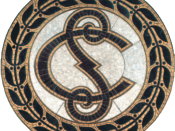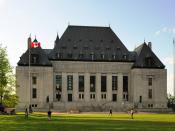Chapter 10
10.1-10.2
1. Define "tort" and give three original examples of torts.
Tort- a civil wrong or injury, other than breach of contract, for which the injured party may seek damages from the wrongdoer
Ex: car accidents, property damages, personal possessions
2. Why is tort law constantly changing?
Tort law is constantly changing because society is constantly recognizing the effect of different circumstances and their results.
Ex. Wearing bicycle helmets. - recognizing that a helmet does protect again serious head trauma.
3. Using an original example, explain how an offence can be both a crime and a tort.
Ex: Leaving your swimming pool open to the public without proper safety precautions in place.
4. What is the primary purpose of tort law?
5. Name the secondary purposes of tort laws.
The primary purpose of tort laws is to compensate the victim for present and future expenses.
10.3
1. What kinds of dollars limits exist for cases tried in Small Claims Court?
Depending on the province you live in depends on the limit you can claim for.
It ranges from $1000- $10 000.
2. List four examples of cases that could be tried in your province's Small Claims Court.
Landlord and tenant conflicts, consumer complaints, unpaid bills, recovery of personal property, unpaid wages, consumer debts, and claims for minor car accidents.
3. Why are juries seldom used in civil suits?
They are not used because it helps to keep the cost of the court to a minimum.
4. What types of appeals will the Supreme Court of Canada hear?
They will only hear cases from the Federal Court of Canada and Provincial Court of Appeal that they believe are of national importance or in which an important issue or question of aw must be decided or interpreted.
10.4
1. Explain the meaning of "balance of probabilities" as it relates to civil actions.
Balance of probabilities- the degree of proof in a civil action; a greater likelihood.
2. Why must a minor be represented by a "next friend" in a civil suit?
If the person is under the age of majority, 18 or 19 years of age, who wishes to sue, must be represented by an adult who will ensure that the minor's action is responsible.
3. List four key pieces of information that must appear on a summons or claim?
Must include the full name and address of the plaintiff, the full name and address of the defendant, the reason for the claim and the amount the plaintiff is suing for.
4. Briefly outline the four options available to a defendant who is being sued.
÷ The defendant can pay the amount plus the costs to the Small Claims Court office within 10 days,
÷ The defendant can pay part of the claim to the Small Claims Court office and wait for the plaintiff to accept the amount and drop the balance of the claim or pursue the case
÷ The defendant can prepare a statement of defense, which outlines the reasons for disagreeing with the claim
÷ The defendant can also make a counter claim against the plaintiff
5. What is a default judgment?
A default judgment is a decision made in the plaintiff's favor when the defendant does not dispute the plaintiff's claim within the required time
6. What is an Examination of Discovery? List its three purposes.
Examination of Discovery is a civil pre-trial process to disclose evidence and relevant documents and to reach agreement on certain issues to be presented at trial.
(Mediation)
Three purposes for this is
÷ Reduce court time
÷ Saves money
÷ Makes settlement easier
7. What are the benefits of an out-of-court settlement?
The benefits are that both parties have the chance to reach a decision before the judge orders his/her decision. It can cause either/both partied to be unsatisfied with the judge's ruling.
8. Why are pre-trial conferences being used more often in civil actions?
They are used more because with the assistance of the judge, the two parties solve as many unsettled issues as possible before the case goes to trial. Trails can cost a lot of money and if an agreement can be reached without having to spend a lot in the beginning, both parties will be better off in the end.
10.5
1. Using examples, distinguish between (a) general and special damages, (b) pecuniary and non-pecuniary losses.
a) general - are items that cannot be calculated easily and require a judge or jury's discretion. Ex: Pain and suffering, mental anguish, the inability to enjoy a normal life
special damages- compensate for out-of-pocket expenses for which the plaintiff can produce a receipt or bill
pecuniary - financial loss such as loss of future earnings and the cost of future care
non-pecuniary losses- loss of enjoyment of life, pain and suffering and the shortening of the victim's life
2. Why is it difficult to determine what damages to award a very young child or a young person between the ages of 7 and 16?
It is difficult to determine damages for a young person who has not yet entered the work force. There is also the problem of determining what the person will do after finishing high school, how their marks in school will affect their entrance to college or university, or simply what type of employment they intend to seek in the future. There is no one to testify on their behalf at the trial to support these claims.
3. Using examples, distinguish between nominal and punitive damages.
Nominal damages- a small sum of money awarded to a plaintiff who has won a civil action but has not suffered substantial harm or loss, money awarded for a moral victory. Ex: someone who trespasses on your property but does not do any damage
Punitive damages- money awarded to a plaintiff, as a deterrent, for the purpose of punishing the defendant for an uncaring or violent act; also called exemplary damages.
4. What is an injunction, and when might it be awarded in a civil judgment?
Injunction- a court order directing a person to do or not to do something
It might be awarded in a civil judgment (ex: when you want to prevent you neighbor in playing their drums late at night or rehearsing)
5. What is a contingency fee system? List one advantage and one disadvantage of this system.
Contingency fee system- arrangement between lawyer and client in which the lawyer will be paid a percentage of whatever sum of money is awarded to the client at trial
An advantage of this system is it allows those who cannot afford to pay legal fees in advance to take legal action.
A disadvantage of this system is that it may cause an excessive number of actions and multi-million dollar lawsuits.
6. Briefly outline three remedies available for enforcing a judgment.
A few remedies for enforcing a judgment can be garnishment of wages, request an examination of the debtor, which the defendant is ordered to appear in court to satisfy the judge as to the availability of resources to settle the claim. You can also seize the assets of the debtor. Or the last remedy available is an automobile judgment where you can send a copy of the final court judgment to the Registrar or Superintendent of Motor Vehicles who has the authority to suspend the defendant's driver's license until the debt is paid or arrangements are made.


